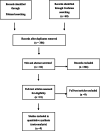Direct anterior approach versus posterolateral approach in total hip arthroplasty: a meta-analysis of results on early post-operative period
- PMID: 33468181
- PMCID: PMC7816494
- DOI: 10.1186/s13018-021-02218-7
Direct anterior approach versus posterolateral approach in total hip arthroplasty: a meta-analysis of results on early post-operative period
Abstract
Background: This study was performed to compare the advantage and disadvantage of posterolateral approach (PLA) and direct anterior approach (DAA) in total hip arthroplasty (THA).
Methods: Relevant trials were identified via a search of the Cochrane Central Register of Controlled Trials and PubMed from inception to 1 June 2019. A meta-analysis was performed to compare postoperative perioperative and radiographic outcomes between DAA and PLA in THA with respect to the hospital stay, blood loss, incision length, operative time, complications, and femoral and cup component position. The Harris Hip Score (HHS) was also assessed before and after 6 months postoperatively.
Results: Nine eligible studies involving 22698 adult patients (DAA group, n = 2947; PLA group, n = 19751) were identified for analysis. Compared with the PLA group, the DAA group had shorter hospital stay and achieved better HHS within 6 months after operation (P < 0.05), but the HHS was no significant differences between the two groups over 6 months (P > 0.05). The DAA group had significantly longer operative time, more blood loss, and complications than the PLA group (P < 0.05). In addition, the femoral component positioned in neutral and cup component inclination angle was comparable between both groups (P > 0.05); however, cup component anteversion angle was significantly larger in the PLA group (P < 0.05).
Conclusion: Patients in the DAA group had higher HHS within 6 months and shorter hospital stay. The DAA could offer rapid early functional recovery after THA compared with the PLA. However, the DAA group often required longer operative time and had more blood loss. Furthermore, there was a higher early complication rate. Therefore, we believe that the direct anterior approach was a more difficult technique. The surgeon should be a well-trained joint surgeon with extensive prior hip replacement experience before performing THA through a DAA, and DAA was not suitable for beginners performing THA. In addition, we did not observe the difference with regard to the femoral component position and cup component inclination angle except for the smaller cup component anteversion angle in DAA group.
Keywords: Direct anterior approach; Meta-analysis; Posterolateral approach; Total hip arthroplasty.
Conflict of interest statement
The authors declare that they have no competing interests.
Figures









Similar articles
-
Patient-reported results of simultaneous direct anterior approach and posterolateral approach total hip arthroplasties performed in the same patients.J Orthop Traumatol. 2021 Nov 13;22(1):46. doi: 10.1186/s10195-021-00611-w. J Orthop Traumatol. 2021. PMID: 34773489 Free PMC article. Clinical Trial.
-
Total hip arthroplasty by direct anterior approach in the lateral position for the treatment of ankylosed hips.Eur J Orthop Surg Traumatol. 2020 Aug;30(6):993-1001. doi: 10.1007/s00590-020-02655-w. Epub 2020 Mar 17. Eur J Orthop Surg Traumatol. 2020. PMID: 32185574
-
Comparison of Early Functional Recovery After Total Hip Arthroplasty Using a Direct Anterior or Posterolateral Approach: A Randomized Controlled Trial.J Arthroplasty. 2017 Nov;32(11):3421-3428. doi: 10.1016/j.arth.2017.05.056. Epub 2017 Jun 8. J Arthroplasty. 2017. PMID: 28662957 Clinical Trial.
-
A systematic review and meta-analysis of direct anterior approach versus posterior approach in total hip arthroplasty.J Orthop Surg Res. 2018 Sep 6;13(1):229. doi: 10.1186/s13018-018-0929-4. J Orthop Surg Res. 2018. PMID: 30189881 Free PMC article.
-
Clinical, functional and radiographic outcomes of primary total hip arthroplasty between direct anterior approach and posterior approach: a systematic review and meta-analysis.BMC Musculoskelet Disord. 2020 Jun 2;21(1):338. doi: 10.1186/s12891-020-03318-x. BMC Musculoskelet Disord. 2020. PMID: 32487060 Free PMC article.
Cited by
-
Results of the transition from posterolateral to anterior minimally invasive approach for total hip arthroplasty.J Orthop Surg Res. 2023 Oct 31;18(1):816. doi: 10.1186/s13018-023-04291-6. J Orthop Surg Res. 2023. PMID: 37907985 Free PMC article.
-
Stratified Comparison of Short-Term Perioperative Outcomes in Direct Anterior Versus Posterolateral Primary Total Hip Arthroplasty: A Retrospective Review.HSS J. 2025 Mar 14:15563316251323612. doi: 10.1177/15563316251323612. Online ahead of print. HSS J. 2025. PMID: 40092734 Free PMC article.
-
Bone Density May Be a Promising Predictor for Blood Loss during Total Hip Arthroplasty.J Clin Med. 2022 Jul 7;11(14):3951. doi: 10.3390/jcm11143951. J Clin Med. 2022. PMID: 35887715 Free PMC article.
-
The Direct Anterior Approach versus the Posterolateral Approach on the Outcome of Total Hip Arthroplasty: A Retrospective Clinical Study.Orthop Surg. 2022 Oct;14(10):2563-2570. doi: 10.1111/os.13444. Epub 2022 Sep 3. Orthop Surg. 2022. PMID: 36056786 Free PMC article.
-
Should we be concerned when the anterior approach to the hip goes accidentally medial? A retrospective study.Arthroplasty. 2024 Sep 1;6(1):47. doi: 10.1186/s42836-024-00269-9. Arthroplasty. 2024. PMID: 39217376 Free PMC article.
References
Publication types
MeSH terms
Grants and funding
LinkOut - more resources
Full Text Sources
Other Literature Sources
Medical

